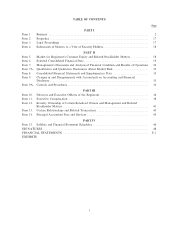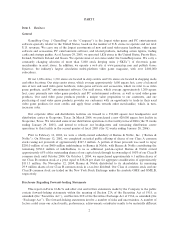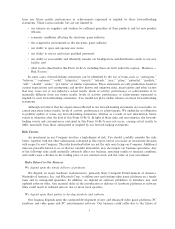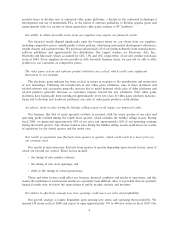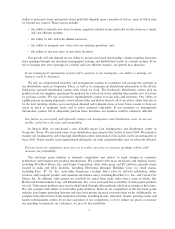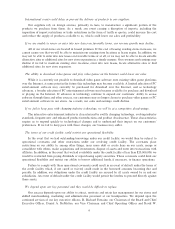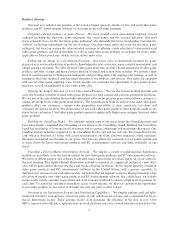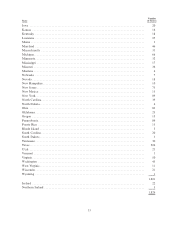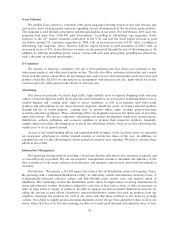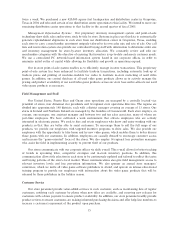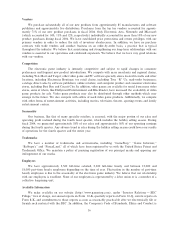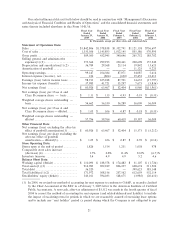GameStop 2004 Annual Report Download - page 18
Download and view the complete annual report
Please find page 18 of the 2004 GameStop annual report below. You can navigate through the pages in the report by either clicking on the pages listed below, or by using the keyword search tool below to find specific information within the annual report.promote trade-ins of used video game products in our stores and to leverage our web site at
www.gamestop.com.
Merchandise
Substantially all of our revenues are derived from the sale of tangible products. Our product oÅerings
consist of new and used video game products, PC entertainment software, and related products, such as action
Ñgures, trading cards and strategy guides. Our in-store inventory generally consists of a constantly changing
selection of over 5,000 SKUs. We have a central buying group that negotiates terms, discounts and
cooperative advertising allowances for all of our stores. We use customer requests and feedback, advance
orders, industry magazines and product reviews to determine which new releases are expected to be hits.
Advance orders are tracked at individual stores to distribute titles and capture demand eÅectively. This
merchandise management is essential because a signiÑcant portion of a game's sales are usually generated in
the Ñrst days and weeks following its release. We also carefully manage product pricing utilizing a tiered-
pricing strategy that enables us to tailor pricing at our stores based on each store's competitive environment.
Video Game Software. We purchase new video game software directly from the leading manufacturers,
including Sony, Microsoft and Nintendo, as well as over 40 third-party game publishers, such as Electronic
Arts, Take-Two Interactive and Activision, Inc. We are one of the largest customers in the United States of
video game titles sold by these publishers. We carry over 1,000 SKUs of new video game software at any given
time across a variety of genres, including Sports, Action, Strategy, Adventure/Role Playing and Simulation.
Used Video Game Products. We are the largest retailer of used video games in the United States. We
provide our customers with an opportunity to trade in their used video game products in our stores in exchange
for store credits which can be applied towards the purchase of other products, including new merchandise. We
have the largest selection (over 4,000 SKUs) of used video game titles which have an average price of $13 as
compared to $35 for new video game titles and which generate signiÑcantly higher gross margins than new
video game products. Our trade-in program provides our customers with a unique value proposition which is
unavailable at mass merchants, toy stores and consumer electronics retailers. This program provides us with an
inventory of used video game products which we resell to our more value-oriented customers. In addition, our
highly-customized inventory management system allows us to actively manage the pricing and product
availability of our used video game products across our store base and to reallocate our inventory as necessary.
Our trade-in program also allows us to be one of the only suppliers of previous generation platforms and
related video games. We also operate a refurbishment center where defective video game products can be
tested, repaired, relabeled, repackaged and redistributed back to our stores.
Video Game Hardware. We oÅer the video game platforms of all major manufacturers, including Sony
PlayStation 2 and PlayStation, Microsoft Xbox, Nintendo DS, GameCube and Game Boy Advance SP. We
also oÅer extended service agreements on video game hardware. In support of our strategy to be the
destination location for electronic game players, we aggressively promote the sale of video game platforms.
Video game hardware sales are generally driven by the introduction of new platform technology and the
reduction in price points as platforms mature. Due to our strong relationships with the manufacturers of these
platforms, we often receive disproportionately large allocations of new release hardware products, which is an
important component of our strategy to be the destination of choice for electronic game players. We believe
that selling video game hardware increases store traÇc and promotes customer loyalty, leading to increased
sales of video game software and accessories, which have higher gross margins than video game hardware.
PC Entertainment and Other Software. We purchase PC entertainment software from over 35
publishers, including Electronic Arts, Microsoft and Vivendi Universal. We oÅer PC entertainment software
across a variety of genres, including Sports, Action, Strategy, Adventure/Role Playing and Simulation.
Accessories and Other Products. Video game accessories consist primarily of controllers, memory cards
and other add-ons. PC entertainment accessories consist primarily of video cards, joysticks and mice. We also
carry strategy guides and magazines, as well as character-related merchandise, including action Ñgures and
trading cards. We carry over 750 SKUs of accessories and other products. In general, this category has higher
margins than new video game and PC entertainment products.
11


